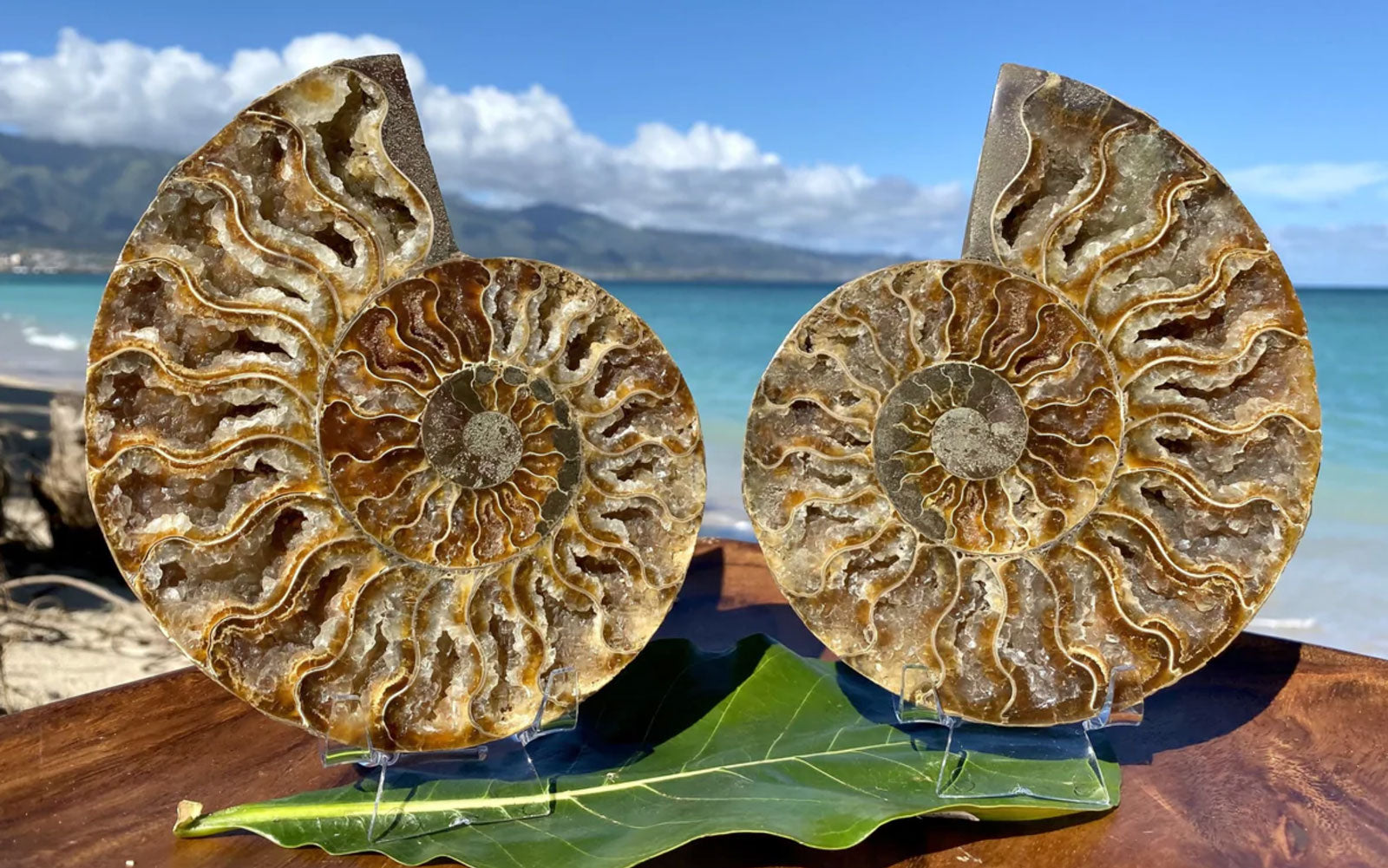
Ammonite Fossils: All About the Most Versatile Artifact
Mother Nature provides us with valuable information about history and cultures wherever we look. Ancient civilizations valued things like fossils, animal teeth, and even healing crystals because they believed they provided their communities with various blessings and protections. Ammonite Fossils are no exception - their healing properties are believed to range from aiding in digestion to reducing pain during childbirth to so much more.
Ammonite fossils have both a fascinating history and many uses today. Fossil enthusiasts and jewelry lovers alike treasure ammonites for the variety of shapes, colors, and sizes found globally. With a rich history and stunning beauty, ammonites have been a commodity for centuries.
What are Ammonite Fossils?
Ammonite fossils are the remains of ammonites, also known as ammonoids or ammonoidea, a type of cephalopod. Cephalopods were a group of predators that often inhabited shallow areas of bodies of water all over the world.
Ammonites lived over a span of about 140 million years during the Jurassic and Cretaceous periods. Some cephalopods, like ammonites, are extinct and are known only by the fossils they leave behind. There are many other types of cephalopods still around today, including:
- Octopuses
- Squid
- Cuttlefish
Ammonites gained their name from the Greek god Ammon, who was depicted as having large, spiral horns. Upon finding the fossils, ancient civilizations named them after the god, believing they harnessed similar powers.
How Did Ammonites Become Fossilized?
Ammonite fossils are most recognizable by their signature spiral design, often with stripes or ribs across the shell. Their shells used to provide the house for the actual animal, but the fossilization process preserved the shell fossil we know today.
The type of fossilization that occurred with these organisms is called permineralization, a process in which minerals fill up the empty space of the vacant shell and become petrified over time, leaving the beautiful fossil recognizable to folks all over the world.
Ammonite Fossils: Healers and Educators
One of the most fascinating things about fossils is learning how ancient civilizations used and valued them. Many elements of nature have been used in medicine for generations, and ammonite fossils are thought to have many healing properties. Simply possessing the fossils is powerful, but some communities have been known to grind and consume them, as well.
Ammonite fossils are largely regarded as providing guidance and clarity to those who possess them. Many cultures, including ancient Greeks and indigenous communities in North America, also believe they can shield their people from danger and illnesses. As populations moved to new locations across the earth, they often carried ammonites and other artifacts for protection.
What Can We Learn From Ammonite Fossils?
Aside from healing properties, scientists have learned a great deal about natural history from ammonite fossils. For instance, scientists have discovered that the diet patterns of these ancient creatures were most likely very similar to modern cephalopods, allowing us to make large discoveries about the way these organisms survived.
This information can also spark the curiosity of scientists and influence future research about modern sea animals. Due to the extensive time period in which they existed, they are also helpful to scientists when attempting to date other fossils.
Ammonite fossils are also an excellent example of evolution and have allowed researchers to understand how and why certain organisms might change throughout time. For example, ammonites can be found in varieties less than one centimeter in length all the way up to several meters in diameter.
The proposed theories about these shell differences are that some ammonites grew more quickly than others, depending on what kind of predators surrounded their populations. The bigger the predators, the bigger and thicker the ammonite shell. On the contrary, some species may have remained small to be able to easily camouflage from potential threats.
Where are Ammonite Fossils Found?
Fortunately for fossil hunters around the world, ammonite fossils can be found on beaches globally. Because they often lived in shallow waters, ammonite shells are likely to wash up on the shores of oceans, lakes, and rivers. Ammonite fossils have been found on all seven continents. Some of the richest ammonite deposits exist in:
- Greece
- Madagascar
- Antarctica
Antarctica is a surprising location, but some of the largest and most impressive ammonite fossils are found in Antarctica and its surrounding islands. This is likely due to the simple lack of human interference coupled with preservation efforts all over the continent. Undisturbed land is a hotbed for many fossils, gemstones, and other natural resources.
Several state parks in the U.S. are also known for their rich ammonite deposits. Because they’re on islands, national parks in Hawaii have large quantities of ammonites. These cool fossils can make for a popular tourist attraction and souvenir opportunity.
Ammonite Fossils Make Unique Gifts
Ammonite fossils of all shapes and sizes make excellent keepsakes and gifts. Since many believe they possess protection and healing powers, a decorative split pair of fossils might make a wonderful housewarming or get-well-soon present. For the traveler in your life, an ammonite fossil from a specific place like Madagascar could remind them of their beloved adventures around the world.
If you’d like to impress the lady in your life, consider gifting her gorgeous ammonite fossil jewelry! A new necklace or pair of earrings is a great opportunity to add a little natural flair to an outfit. Since many ammonites have neutral colors, they can elevate just about any look.
Best Ammonite Fossil Gifts:
Ammonite fossils are also very durable due to the nature of their creation; the pressure under which they are created allows their shells to remain sturdy, ensuring that your ammonite jewelry will last a lifetime!
How Do I Know if I Have a Legitimate Ammonite Fossil?
Fortunately for those seeking ammonites, there are many legitimate places to find ammonite fossils. In areas where ammonites are plentiful, gift shops often stock the fossils for tourists and locals alike. In Hawaii, Whaler’s Locker is a perfect place to find such treasures, among lots of other natural gemstones and classic jewelry pieces. They also offer shipping to all 50 states, making it the perfect place to shop for birthdays and holidays!
Ammonite fossils are one of many natural resources that can be used in creative ways. From the avid fossil collector in your life to the classy jewelry lover, ammonite fossils of all shapes and sizes make fantastic gifts. If you’d prefer to keep all your new treasures for yourself, we won’t tell!



